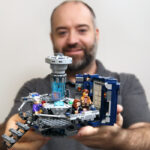As a child, the world of eyewear entered my life around the age of eight with a diagnosis of nearsightedness. Astigmatism soon joined the party, further blurring my vision. Beyond the blurry vision, I was also labeled a behavior problem throughout my school years. In today’s world, I might have been quickly prescribed medication for attention issues. Reading was a chore, school was unappealing, and I was, to put it mildly, a disruptive and frustrating presence in the classroom. My report cards consistently echoed the sentiment, “Steven is not working up to his potential.” Despite my desire to improve, sports requiring hand-eye coordination were also a struggle. I managed to navigate high school and a year of college with decent grades, but with minimal effort – honesty, not pride, dictates that admission.
College wasn’t a priority immediately after high school. After a decade away from formal education, I made a somewhat unexpected decision: to become an optometrist. This path required nearly three years of undergraduate studies followed by a rigorous four-year program at the Pennsylvania College of Optometry. My motivation was deeply personal. I viewed glasses and contact lenses as a significant inconvenience. This personal frustration fueled a desire to liberate myself and others from what I perceived as this visual burden. Around my late twenties, I encountered a book advocating for vision improvement without glasses, and it resonated deeply. My vision for my future practice began to take shape: to blend these alternative approaches with the conventional medical understanding of eye care I knew so well. I wanted to offer a different kind of vision care, something beyond my own experiences as a patient.
During this journey, I uncovered a personal challenge – my eyes weren’t working together as a team. It’s highly probable this issue had been developing and worsening for years, even predating my need for glasses. My experience as an eye doctor has since confirmed this is a common occurrence. This realization led me to vision therapy.
I became convinced that a significant number of children, and adults, who struggle with or avoid reading are unknowingly grappling with underlying visual deficits.
My decision to pursue vision therapy during optometry school was driven by two key reasons. First, I felt it unethical to recommend vision therapy to patients without personally experiencing it. Second, in my twenties, a nagging feeling persisted that something wasn’t quite right with how my eyes functioned. After years of ignoring this, and then learning about behavioral optometry and vision therapy, curiosity piqued. Did I truly have a visual problem, and could it be improved?
As I mentioned, reading was not enjoyable. With my current understanding, I believe I disliked reading because I wasn’t proficient at it. And the reason for my struggles with reading, I now know, stemmed from undiagnosed and untreated visual problems. I strongly believe that many children who express a dislike for reading do so because they are burdened by visual issues they don’t comprehend, or even know exist. Compounding this, they often receive no support to address these underlying problems. Meanwhile, academic workloads, the complexity of reading materials, and educational expectations continue to escalate.
Just as I was starting optometry school, I sought an evaluation from a behavioral optometrist. The diagnosis: my eyes were not teaming effectively. This explained a multitude of experiences throughout my life. Perhaps the most impactful realization was understanding why I had avoided reading throughout my primary education. This eye-teaming issue also clearly elucidated my struggles with sports like baseball and basketball, which demand advanced hand-eye coordination. The question lingered: with countless eye exams since the age of eight, why had every eye doctor simply prescribed stronger glasses and done nothing more?
After years of progressively stronger prescriptions, I had developed a negative perception of glasses. Imagine my surprise to discover that there were eye doctors who prescribed glasses designed to enhance visual abilities, not just sharpen sight.
One of my early mentors in behavioral optometry, Dr. Robert Kraskin, introduced a concept that was initially foreign and challenging for me to accept: the idea that nearly everyone could benefit from wearing glasses. This was a complete reversal of my mission to eliminate these devices! However, as I delved deeper into the underlying factors of this concept (which I will elaborate on further in my next post), I realized the undeniable logic of this approach. There I was, ready to fight against artificial lenses, only to learn they are powerful tools for improving comfort, awareness, productivity, and visual endurance.
My embrace of this philosophy wasn’t based on blind faith. It was the culmination of extensive reading, countless hours of lectures, and personal discussions with leading figures and innovators in the field. This theoretical knowledge was reinforced by years of clinical practice, where thousands of patients consistently demonstrated the positive impact of these principles. My personal experience as a vision therapy patient provided invaluable first-hand knowledge, an experience irreplaceable by any other means. Over my years in practice, I’ve built upon my patient experience by actively guiding each individual through their vision therapy program in my office. This direct involvement provides another layer of unique experience that significantly enriches a vision therapy program.
My passion and dedication to behavioral optometry have grown organically. While my early visual struggles presented significant obstacles, they were, in retrospect, instrumental in shaping my current path. I continuously expand my knowledge by collaborating with colleagues and engaging with leading behavioral optometry practitioners. I am grateful for the ongoing learning opportunities from colleagues and patients alike, and for the chance to help people in a profound way through the benefits of behavioral optometry. I have consistently witnessed the transformative impact of vision therapy across all ages. Learning about vision therapy and the remarkable potential of lenses to go beyond simply correcting clarity is something I have never regretted.
Next up: Lenses. Discover the many surprising ways lenses can be used, ways that remain unknown to most people and even many doctors.

